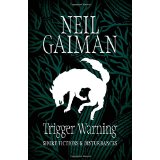 ‘…short stories,’ Gaiman explains in the introduction to Trigger Warning, his third collection of short stories, ‘are the places where I get to fly, to experiment, to play.’ It’s worth knowing this up front. Gaiman also says:
‘…short stories,’ Gaiman explains in the introduction to Trigger Warning, his third collection of short stories, ‘are the places where I get to fly, to experiment, to play.’ It’s worth knowing this up front. Gaiman also says:
”I firmly believe that short-story collections should be the same sort of thing all the way through. They should not, hodgepodge and willy-nilly, assemble stories that were obviously not intended to sit between the same covers.’
‘This collection,’ Gaiman informs us, ‘fails this test.’ He’s right. Trigger Warning fails on a variety of fronts. It fails because it is essentially a car crash between the two things Gaiman says above: on the one hand, you have an excitable, enthusiastic writer, obviously keen on the things he is commissioned to write; on the other hand, you have Gaiman the name, the big writer, who, you know, Stephen King-like, periodically likes to bung everything he’s been up to between covers. Maybe the difference is as simple as, with a writer like King, a short story collection would still be a collection of short stories; with Gaiman, there’s an element of everything but the kitchen sink – and then the kitchen sink – and then the hole where the kitchen sink was – and then a photograph of the hole where the kitchen sink was – and then the negatives – and then the camera – and then yourself – and then your family, your history, your street, your town, your country, the universe, several other universes, whatever is left after all of that and then some more.
So, we have some typical Neil Gaiman stories. We have some typical Neil Gaiman revisionings of fairytales. We have some pieces that feel like writing exercises (ie the kinds of things that should never see the light of day). And we have a bunch of poems. We get the sense, in the intro, that Gaiman is an unapologetic poet (he knows his readers probably don’t read poetry and that they are included here, wilfully, because he can – but, crucially, all of this does not make Gaiman a good poet and his poems are terrible). So reading Trigger Warning is a process of sifting between the good and the bad, and the average and the very terrible. It’s not an experience I’d heartily recommend even though there are stories in here – stories we’ve talked about before like “The Truth is a Cave in the Black Mountains…’ and ‘The Sleeper and the Spindle’ – that are as good as anything Gaiman has written.
The problem with the problematic stories are that they don’t fully come alive. There is a tagline to the book, ‘short stories and disturbances’, which (as well as being a bit pretentious, which Trigger Warning is at times) sets you up for disappointment: there are not a huge number of actual disturbances here (‘Click Clack the Rattlebag,’ maybe, and the American Gods story, ‘Black Dog’, odd excerpts in the ‘Calendar of Tales’, most of ‘The Thing about Cassandra’) and a great deal more examples of what can only be described as eye rolls. You know eye rolls? When someone does something that makes you tut and roll your eyes? That is far more prevalent in Trigger Warning – to the extent that Trigger Warning – Short Stories and Eye Rolls would have been a far, far truer title.
Not that this will hurt Gaiman at all. His fans, we sense, lap up everything. He’s in the enviable position of being critically unassailable in that sense. But Gaiman’s profligacy will hit him at some point. He needs to write less and write better. Not accept every request. Not collect every commission in a single book. Because what you get is a dog’s breakfast.
Any Cop?: The kind of dog’s breakfast in which even the good bits are somewhat spoiled by their inclusion alongside some genuine tat.